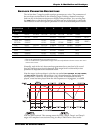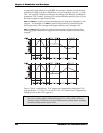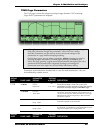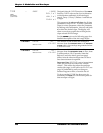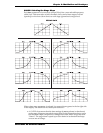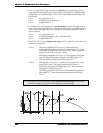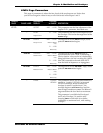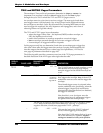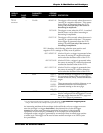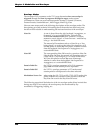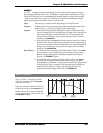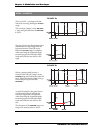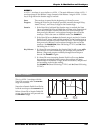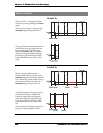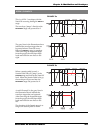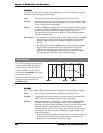
Chapter 6: Modulation and Envelopes
ANDROMEDA A6 REFERENCE MANUAL 143
DISPLAY
PAGE PANEL
LABEL
PARAMETER
DISPLAY
OPTIONS
or RANGE
DESCRIPTION
TRIG
Continued
—
POLAR
*
NEGATIVE
The trigger will occur only when the source is
“moving in a negative direction.” This means
that a trigger is generated when the
LEVEL
setting is reached, but only if the source is
decreasing in amplitude.
BIPOLAR
The trigger occurs when the LEVEL is reached
but the source can be either increasing or
decreasing in amplitude.
POSITIVE
The trigger will occur only when the source is
“moving in a positive direction.” This means
that a trigger is generated when the
LEVEL
setting is reached, but only if the source is
increasing in amplitude.
ABS: Absolute – the following polarities treat positive and
negative
LEVEL settings as if they were all positive.
ABS NEGATIVE
Absolute Negative: a trigger is generated when
the source is moving in a negative direction
and reaches the absolute value of the
LEVEL.
ABS BIPOLAR
Absolute Bi-Polar: a trigger is generated when
the source is moving in a either direction and
reaches the absolute value of the
LEVEL.
ABS POSITIVE
Absolute Positive: a trigger is generated when
the source is moving in a positive direction
and reaches the absolute value of the
LEVEL.
—
MODE
NORM 1
NORM 2
FRERUN
FR-SUS
SUSREL
MODTRG
MOD-TG
Once the envelope is triggered or re-triggered,
this parameter instructs the envelope how to
execute its Attack, Decay, Sustain and Release
stages.
These seven modes are fairly elaborate, so an
extended discussion with examples are
presented starting on the next page.
—
<PAGE>
TRIG
RETRIG
Not only are envelopes triggered, they can
also be configured to be re-triggered. Use soft
knob
8 to toggle between the TRIG page and
the
RETRIG pages of parameters.
* For an in-depth study of these polarities, see our discussion on How Modulation Triggering Works
using an LFO source as the example. This topic starts on page 155.
An interesting attribute of the envelopes is that while they rely on a trigger source to
start (an envelope is a trigger destination), they themselves can also be trigger
sources. One of the more interesting properties of envelopes is the triggering
capabilities of the envelopes’ parameters. As an example, an envelope can be
configured so that a trigger is generated by an envelope when its attack stage
reaches
a certain level. This trigger can be used to start another envelope or an LFO as just a
few possibilities.



